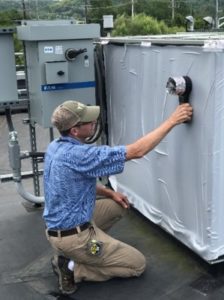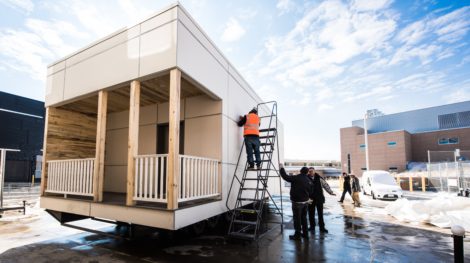Building Energy Audits for Residential or Commercial Buildings

Photo by Piljae Im, ORNL
Note that this challenge was for the Fall 2020 competition.
The objective of this challenge is to develop technical solutions to expedite energy audits or develop a simplified, yet effective, energy audit methodology, by finding ways to reduce time and cost compared to current audit practices. In addition to proposing solutions, this challenge also asks teams to demonstrate the proposed energy audit solution on an existing building.
Background
Buildings, whether long-standing or recently constructed, have potential for energy improvements. Engineers uncover the energy improvement potential for these buildings through thorough inspection, survey of systems and review of past energy usage; a practice commonly referred to as an energy audit.
Energy audits are used in both the residential and the commercial building sectors. An energy audit is a process and inspection survey to understand the energy use of the building and to identify opportunities to improve energy efficiency while maintaining or improving occupants’ comfort. In addition to this, energy audits can be used for energy efficient building certification (e.g. Home Energy Rating System Program [HERS], U.S. Green Building Council [USGBC] Leadership in Energy and Environmental Design [LEED]). The energy audit can range from a simple walk-through of the building to a detailed audit with onsite measurements, tests, and analysis of many, if not all, building systems. ASHRAE (American Society of Heating, Refrigerating and Air-conditioning Engineers) provides industry with three standardized levels of energy audits where thorough on-site investigation is required as audit complexity increases.1
Simple energy audits (ASHRAE Level 1) include a review of utility bills, interviews with building staff, and a walk-through of the building. The purpose of this audit is to identify energy inefficiency and provide recommendations to building owners regarding operational adjustments or system upgrades with cost-effective energy efficiency measures (EEMs). For example, inefficient lightbulbs can be replaced with energy-efficient lightbulbs, such as LEDs. Simply replacing old filters of heating and cooling equipment can save energy by increasing filtration effectiveness and maintaining superior indoor air quality.2 These recommendations are easily identified by a building walk-through and easily implemented by building owners or facility managers where immediate energy savings can be anticipated. Major problem areas can be uncovered by simple energy audits, but level 1 energy audits are often not sufficient for implementing more significant measures and in that case, more detailed energy audits are recommended. Also, the lack of granularity of utility bills reduces the potential for diagnostics and other data processing techniques. In addition, many buildings today are equipped with a vast array of sensors that could provide more meaningful analyses and insight into a building’s operation. Wireless sensors and data acquisition also offers new potential for improving our ability to quickly and efficiently understand energy performance of an existing building. More detailed energy audits (ASHRAE Level 2 and Level 3) provide a comprehensive understanding of the energy usage of building and enables advanced energy efficiency measures and future investment planning. By examining the condition of building envelope and HVAC systems, and operations and maintenance procedures, a baseline for energy usage can be developed to evaluate the cost-effectiveness of pre-selected EEMs.3 For example, a blower door test4 or tracer gas test5 can be performed to identify air leakage or determine the air tightness of the building. Insulation level of the building can be identified based on as-built drawing, while thermal bridging or insufficient insulation can be identified using an IR camera6 together with a blower door test. Remote building energy audit services using new technologies such as advanced data mining techniques or machine learning are under active development.7,8 These potential EEMs, which are identified through detailed energy audits, can be evaluated and prioritized using whole-building energy simulation tools (e.g., EnergyPlus, OpenStudio).
Detailed audits are more expensive and time consuming, and they require more detailed field data but can be necessary to plan an appropriate path forward. Because Level 2 and 3 audits are expensive, they are not performed often, especially for residential buildings, and so significant energy savings are left unrealized.
The Challenge
The JUMP into STEM competition is looking for technical solutions to expedite the audit process or develop a simplified but more effective audit method, by finding ways to reduce time and cost.
Possible solutions could be related to any required tasks in any of the three levels of energy audit (e.g. energy bill analysis, review mechanical and electrical system, building air tightness testing) and many aspects of building (e.g., building envelope, HVAC system, lighting system) to improve the current system for energy efficiency and occupants’ comfort. In addition to proposing solutions, this challenge also asks the teams to test their proposed solution by conducting the energy audit at a local building. Engaging with a local building owner or homeowner can be a great way to identify improvements in the solution as well as identify EEMs for the owner or homeowner.
Solutions may address either residential or commercial buildings and should include the following:
- The proposed technical solution and how the solution will benefit or improve the audit process
- Site assessment including a virtual visit, virtual interviews of building staff if necessary (e.g., homeowner, facility managers, operations and management staff)
- Energy usage analysis (e.g., collect and analyze at least one year of utility data)
- The expected impact of the energy audit; examples of impact include energy saving potential using a whole building energy simulation tool (e.g., EnergyPlus, OpenStudio) or other relevant methods to capture the scientific effects of the propose method, economic benefit, and indoor environment comfort
- Feedback on energy audit outcomes (e.g., a list of recommended EEMs, cost-benefit analysis) from the homeowner, local building staff, etc.)
- A technology-to-market plan for how to scale up this solution to make an impact on the building industry
Downloadable Challenge Description
Additional Challenge Resources
Requirements
Competing in this challenge is open to student teams currently enrolled in U.S. universities and colleges. See the Terms and Conditions for eligibility requirements. Please note that you must begin your Building Technologies Internship Program (BTIP) application before or at the same time as you submit your idea in order to compete in the JUMP competition.
Please submit the following as one PDF document.
- Project Team Background (up to 2 pages, single-spaced)
-
- Form a team of 2 to 4 students. These students represent the project team, and will all consult on the problem.
- The Project Team Background should include:
- Project name, team name, and collegiate institution(s)
- Team mission statement
- A short biography for each team member. Include information such as major, level (freshman, sophomore, junior, senior, graduate), and other relevant background information such as experience with building science, future career goals, and formative experiences that shaped each individual’s contribution to the challenge.
- Diversity Statement (one paragraph 5-7 sentences): One of JUMP into STEM’s key objectives is to encourage diversity of thought and background in students entering the building science industry. There is a diversity gap in the industry, meaning that it is underrepresented by certain groups—including, but not limited to, those based on race, ethnicity, and gender—and this gap needs to be addressed. Diversity of thought can be achieved through teams consisting of students from different majors and minors. As part of the next generation of building science thought leaders and researchers, you have a unique opportunity to influence this industry. Please describe how your team is contributing to diversity in building science
-
- The Project Team Background does not count toward the 5-page Project Challenge Submission.
-
- Project Challenge Submission (up to 5 pages, single-spaced)
- Select one of the three challenges to address
- Investigate the background of the challenge and consider related stakeholders. Stakeholders are those who are affected by the problem as well as those who may have decision-making power and provide solutions (technical or nontechnical, such as policies). Include any market stakeholders, such as manufacturers.
- Write a one- to two-paragraph problem statement, focusing on a specific aspect of the problem and a stakeholder group affected by the problem. The stakeholder group can be from a specific location, socioeconomic status, age, or demographic (e.g., people living in subsidized housing).
- Write a technical solution or process that addresses or solves the specific problem from your problem statement. Address the requirements for your selected challenge. Include graphs, figures, and photos.
- Develop a one- to two-paragraph technology-to-market plan that describes how the team envisions bringing their idea from paper concept to being installed on real buildings or integrated into the design of real buildings. Include cost and benefit analyses in the technology-to-market plan. This does not need to be exhaustive and should focus on comparing the solution to current or existing practices. Benefits such as building energy reductions and improved occupant health or productivity should be evaluated.
- Appendix (optional, no page limit)
- Teams may wish to add an appendix. This is optional and might not be reviewed by the judges.
- The appendix has no page limit.
Evaluation Criteria
Technical (40%)
- Technical solution or process: how well the proposed technology addresses the problem.
- Technical feasibility: the solution’s technical feasibility/potential, including the viability of the proposed technology. For example, solutions that are not technically possible or that lack a technical feasibility discussion will receive lower scores.
- Technology-to-market plan: the proposed technology-to-market plan, including the team’s cost/benefit analysis of the solution. How technically feasible is the proposed plan to bring the solution from a paper concept to installation or integration with real buildings or building designs? Costs and benefits can include both monetary and non-monetary evaluations.
- Technical response: how well the team’s written submission responds to the technical requests of the challenge.
Innovation (30%)
- Market characterization and readiness for proposed idea: team’s description and understanding of the market and how the solution will create economic value to drive industry adoption.
- Replicability and scalability: team’s description on how they will produce the product cost-effectively and scale the idea beyond original prototypes.
- Novelty: the originality and creativity of the solution and how significant the contribution will be to the building industry.
Diversity and Applicability (30%)
- Diversity statement: how well the team addresses the diversity gap in the building science industry in the diversity statement. This includes how the team brings perspectives from a variety of backgrounds, including students from groups that are underrepresented in science, technology, engineering, and math (STEM). This also includes students from many different disciplines—diversity of thought.
- Stakeholder engagement: how well the team understands their stakeholder community and creates a problem statement around this community’s challenges.
- Applicability to stakeholders: how well the solution addresses the problem statement and associated stakeholder community.
